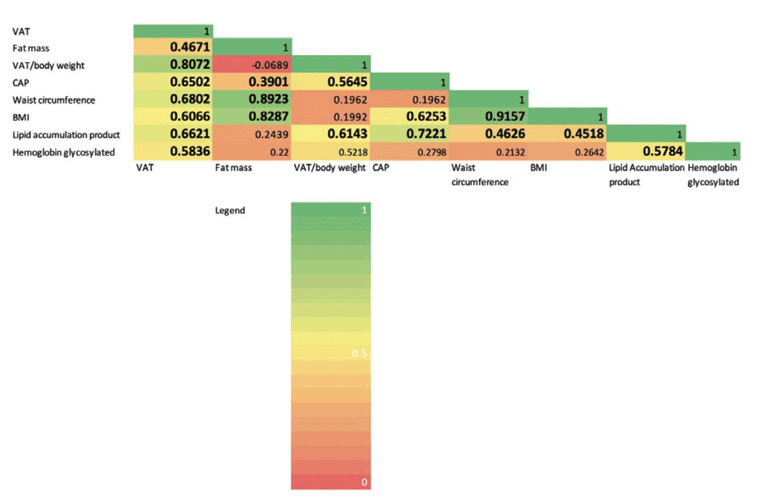 |
 |
 |
| |
CONTROLLED ATTENUATION PARAMETER IS A
VISCERAL ADIPOSITY MARKER IN HIV-RELATED NAFLD
|
| |
| |
CROI 2023 Feb 20-23
NAFLD diagnosed by CAP is associated with VAT in PWH independently of anthropometric measures of obesity. CAP could be used as a potential marker of visceral adiposity in the practice of HIV medicine.
Larger studies with a HIV-uninfected control group, longitudinal design and long follow-up data are needed.
Wesal Elgretli1, Nathalie Paisible2, Cecilia Costiniuk2, Joseph Cox2, Dana Kablawi2, Marina Klein1, Nadine Kronfli2, Jean-Pierre Routy2, Julian Falutz2, Giovanni Guaraldi3, Bertrand Lebouché2, Giada Sebastiani1
1McGill University, Montreal, QC, Canada, 2McGill University Health Centre, Montreal, QC, Canada, 3University of Modena and Reggio Emilia, Modena, Italy
program abstract
Background: Fat alterations are frequent in people with HIV (PWH) and predict worse cardiometabolic outcomes. Visceral adipose tissue (VAT) is a hormonally active tissue critically contributing to obesity-related disorders and associated with ectopic fat accumulation in the liver. We aimed to investigate HIV-associated nonalcoholic fatty liver disease (NAFLD) diagnosed by controlled attenuation parameter (CAP) as a marker of visceral adiposity.
Methods: We conducted a prospective pilot study (ClinicalTrials.gov NCT05359471) of HIV mono-infected patients undergoing metabolic characterization and paired CAP by transient elastography with dual-energy X-ray absorptiometry (DEXA) scan. NAFLD was defined as CAP ≥285 dB/m, in absence of alcohol abuse. Excess visceral adiposity was defined as VAT >1.32 Kg. Pairwise correlation, area under the curve (AUC) and logistic regression analysis were employed to study the association between VAT and CAP.
Results: 30 patients (90% male, mean age 49, mean BMI 30, mean waist circumference 101, 50% with NAFLD) were included. When compared to those without excess VAT, PWH with excess VAT were older, had longer duration of HIV infection, had higher BMI and waist circumference. They also had more history of cardiovascular events, higher triglycerides and LDL cholesterol.
CAP was higher in PWH with excess VAT (319 vs. 213 dB/m, p< 0.001).
CAP positively correlated with all visceral fat measurements by DEXA, including VAT (r=0.650, p< 0.001), VAT/body weight ratio (r=0.565, p=0.001) and fat mass (r=0.390, p=0.033).
Both BMI and waist circumference showed correlation with VAT and fat mass, but not with VAT/body weight ratio (see Figure).
After adjusting for duration of HIV infection (aOR 1.01 per year, 95% CI 0.91-1.12; p=0.921), BMI (aOR 1.77, 95% CI 0.74-4.23; p=0.202) and waist circumference (aOR 0.91 per cm, 95% 0.68-1.21; p=0.509), CAP remained the only independent predictor of excess VAT (aOR 1.05 per dB/m, 95% CI 1.01-1.10; p=0.036).
The AUC analysis determined CAP had excellent performance to diagnose excess VAT (AUC 0.92, 95% CI 0.81-1.00), higher than BMI (AUC 0.83, 95% CI 0.68-0.99) and waist circumference (AUC 0.81, 95% CI 0.65-0.97). The optimized CAP cut-off to diagnose excess VAT was 266 dB/m, with a sensitivity of 88.3% and a specificity of 84.6%.
Conclusion: NAFLD diagnosed by CAP is associated with VAT in PWH independently of anthropometric measures of obesity. CAP could be used as a diagnostic marker of visceral adiposity in the practice of HIV medicine. Correlation matrix with heatmap based on correlation coefficient analysis. Significant values (p<0.05) are bolded.

|
| |
|
 |
 |
|
|